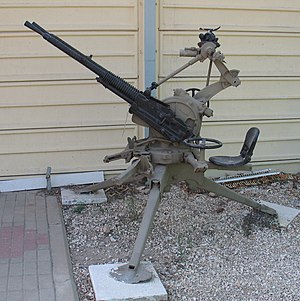Hotchkiss 13.2 mm machine gun
| Hotchkiss model 1930 | |
|---|---|
 A mitrailleuse de 13.2 mm CA mle 1930, in Batey ha-Osef Museum, Tel Aviv, Israel. | |
| Type | Heavy machine gun |
| Place of origin | France |
| Service history | |
| Used by | See Users |
| Wars | Second World War |
| Production history | |
| Manufacturer | Hotchkiss |
| Specifications | |
| Mass | 37.5 kg (83 lbs) single gun, stripped |
| Length | 1.67 metres (5 ft 6 in) |
| Barrel length | 1 metre (3 ft 3 in) |
| Cartridge | 13.2 x 96 mm |
| Caliber | 13.2 mm |
| Action | gas |
| Rate of fire | 450 rounds/min (cyclic) |
| Muzzle velocity | 800 m/s (2,625 ft/s) |
| Feed system | 30-round box magazine |
The 13.2 mm Hotchkiss machine gun was a heavy machine gun designed and manufactured by Hotchkiss et Cie from the late 1920s until World War II when it saw service with various nation's forces, including Japan where the gun was built under licence.[1]
Development
In the late 1920s, Hotchkiss proposed a range of anti-aircraft automatic weapons in the 13.2, 25 and 37 mm calibres. They were all based on the same type of gas-operated action. The 8 mm mle 1914 machine gun had proven extremely reliable during World War I and was still in service. Hotchkiss also advertised the 13.2 mm machine gun as an infantry weapon that could be fitted on conventional tripods and be used against light armour. French infantry commanders that had expressed interest in acquiring light anti-aircraft guns refused to accept the 13.2 mm. They argued that those heavy bullets falling down could be dangerous to friendly troops, and went to larger calibres where self-destructing shells were available. But the 13.2 mm Hotchkiss saw extensive use as a naval gun, and was also chosen by the French cavalry for some of its armoured vehicles.

Service
As a ground-based anti-aircraft weapon
The French Air Force used a twin mounting on a tripod carriage, designated as mitrailleuse de 13,2 mm CA mle 1930, for close-range defence of its airfields and other strategic places.

As a naval weapon
Early in World War II, the French and Japanese navies were using twin and quadruple mountings on many of their warships. French warships that were refitted in the USA in 1943, such as the battleship Richelieu or the destroyer Terrible, had their 13.2 mm machine guns replaced by more efficient Oerlikon 20 mm cannons.
The Spanish Navy bought this weapon in December 1935 and used it during the Civil War (where it was mounted in several Republican Navy destroyers and cruisers).
The "Pirotecnia Militar" Army Ammunition plant (Sevilla) produced its cartridges after 1939.
In Italy, the Società Italiana Ernesto Breda bought a production license in 1929 and manufactured the gun as the Breda Mod.31 from 1931 onwards, to be used on board Royal Italian Navy armed trains, on CV33 light tanks sold to Brazil, and on the command tanks of the Royal Italian Army. After World War II it was used on the patrol boats of the Guardia di Finanza naval service.
As a ground weapon
The 13.2 mm Hotchkiss was used on the Belgian T15 (a combat vehicle) and the French AMR 35, light tanks as well as the AMD Laffly 80 AM [1]armoured car and on fortifications. The Japanese mounted license-produced version of the gun on a number of Type 92 Heavy Armoured Cars which had initially been armed with only a pair of 6.5mm machine guns.
Self-propelled mountings
Several self-propelled anti-aircraft combinations were tested in the 1930s, with Citroën-Kegresse or Berliet chassis, but none was mass-manufactured. The Free French used field-modified self-propelled mountings, with guns recovered from French ships, in North-East Africa in 1942.
Users
See also
- Anti-aircraft
- 25 mm Hotchkiss anti-aircraft gun, a closely related weapon
References
Further reading
- Ferrard, Stéphane. France 1940 l'armement terrestre, ETAI, 1998, ISBN 978-2-7268-8380-8
- "Las armas de la guerra civil española", José MAría MANRIQUE, ISBN 84-9734-475-8, pages 394 -398
